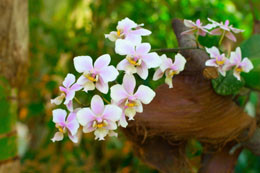As of date, more than 100,000 hybrids of orchids have been created and cultivated. One of the most interesting facts about orchids is that these large sized spectacular flowers produce the smallest seeds that are difficult to view with our naked eyes. For more orchid facts, keep reading...

Orchids are easily identifiable from the colorful petals and distinct, bilaterally symmetrical flower shapes. The taxonomic family of orchids (
Orchidaceae) is the largest in the plant kingdom. According to botanical data, there are approximately 800 genus of orchids, which account for more than 30,000 different species. The term orchid was coined in 1845 from the Greek word for testicle (
orkhis), owing to the appearance of plant roots. Interesting facts about orchids are highlighted in the upcoming paragraphs.
Interesting Orchid Facts
Classification
Orchid plants are classified under the division
Magnoliophyta, which represents flowering seed plants. The taxonomic class of orchids is
Liliopsida, thus sharing it with the monocotyledonous lilies and grasses. They are grouped under the family
Orchidaceae of the order
Asparagales. Because of their adaptability to varied climatic conditions, orchids are next to grasses in distribution.
Diversity
Truly speaking, there is no other plant species that is as diverse as the orchids. The largest orchid type (giant orchid or (
Grammatophyllum)) is about 10 cm across, while the smallest orchid measures 2 mm in size. Some orchid plants are very small, while there are also 20 feet tall orchids. Even a few species of orchids are adapted to underground growing habit, in which only the flower stalks sprout above the ground for pollination.
Distribution
Except for the extreme cold conditions of Antarctica, orchids are grown everywhere in the world. Mention any type of habitat (deserts, tundra, grasslands, rainforest), and orchids are available. However, the number of species is found to be highest in the tropical conditions of Asia, Africa and America. The abundance of orchids decreases as the temperature goes down.
Growth Habit
Facts about growth habit of orchids are known to all of us. In general, they are epiphytes and cling to the tree trunks. The exposed roots obtain moisture and nutrition from natural sources like atmospheric air and rain. However, unlike parasite plants, they do not cause any harm to the host plants. The terrestrial orchids and lithophytic orchids grow in soil and rocks respectively.
Terrestrial Orchids
Orchids are native to the warm and humid climatic conditions of the tropics. But, in temperate regions and forest floor of the tropics, they mostly grow in soil like other plants. There is an interesting part about growing terrestrial orchids in ground soil. They have a symbiotic relationship with various strains of fungi, which colonize the roots. Some orchids (e.g.,
Cephalanthera) are associated with specific species of fungi.
Growth Pattern
Orchids are either monopodial or sympodial in their growth habit. Monopodial orchids (e.g., phalaenopsis) have an upright vegetative apex, and new leaves develop in an alternate fashion from the central stem. The flower stalk shoots up from the stem, from amongst the leaves. On the other hand, sympodial orchids (e.g., dendrobiums) develop pseudobulbs from the rhizome and they grow in a horizontal manner.
Pollination
Pollination is highly specialized for this group of flowering plants. Besides colorful petals, some species produce strong fragrances to attract pollinating agents (particularly insects). The long shelf life of orchid blooms is an adaptation to increase pollination chances. In short, the pistil remains receptive for an extended period. For homegrown orchids, flowers can be hand pollinated to collect minute seeds.
Germination
Despite the fact that orchids produce seeds, they are commonly propagated by vegetative methods. The main reason for this is, difficulty in germination in garden soil or potting media. Yes, the tiny orchid seeds (devoid of stored nutrients) depend on fungi for sprouting. This symbiotic relationship is termed as orchid mycorrhiza. The fungi collect carbon from nearby plants and provide it to the seeds to promote germination.
Cultivation
Orchids hold a reputation of exotic plants, and they were grown under controlled conditions previously. But, growing these lovely flowering plants in indoor rooms and outdoors is no longer a challenge for home gardeners, thanks to the improved plant hybridization approaches, which enabled production of many tropical orchid hybrids. Planting orchids in pots is best proceeded in soilless mix, or they can be grown in well-drained soil.
These were some interesting facts about orchids. More and more hybrids of orchids are being developed to suit varied growing conditions, thus providing a lot of choices for avid gardeners. Growing orchids as houseplants requires stringent watch over the indoor conditions to provide suitable growth factors, like high humidity, warm temperature, moderate moisture, filtered light and more importantly, optimal air circulation in the root zone.






 Orchids are easily identifiable from the colorful petals and distinct, bilaterally symmetrical flower shapes. The taxonomic family of orchids (Orchidaceae) is the largest in the plant kingdom. According to botanical data, there are approximately 800 genus of orchids, which account for more than 30,000 different species. The term orchid was coined in 1845 from the Greek word for testicle (orkhis), owing to the appearance of plant roots. Interesting facts about orchids are highlighted in the upcoming paragraphs.
Orchids are easily identifiable from the colorful petals and distinct, bilaterally symmetrical flower shapes. The taxonomic family of orchids (Orchidaceae) is the largest in the plant kingdom. According to botanical data, there are approximately 800 genus of orchids, which account for more than 30,000 different species. The term orchid was coined in 1845 from the Greek word for testicle (orkhis), owing to the appearance of plant roots. Interesting facts about orchids are highlighted in the upcoming paragraphs.